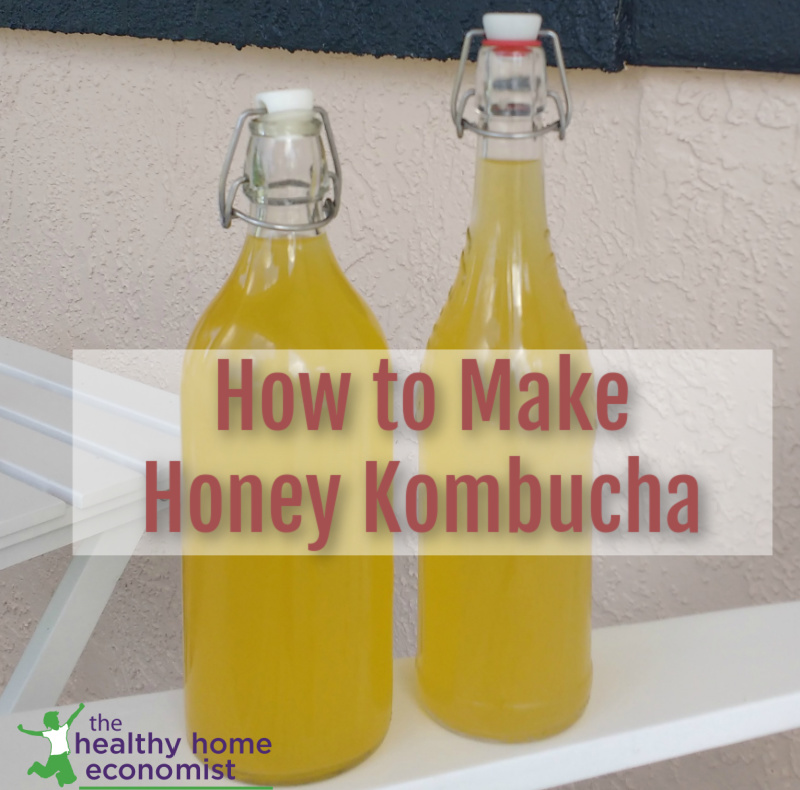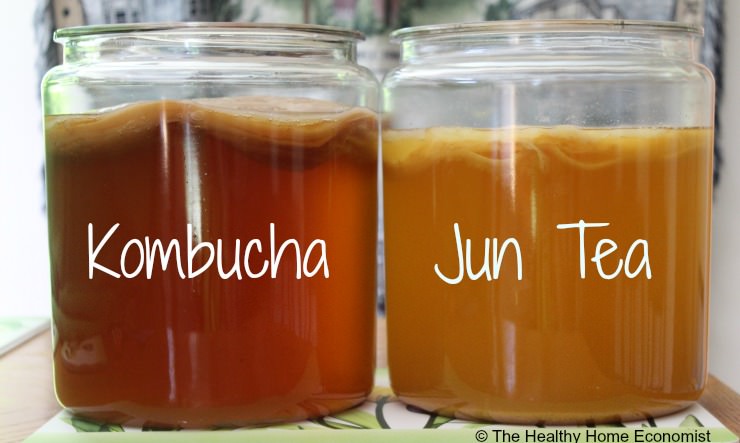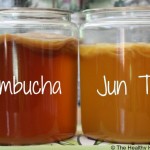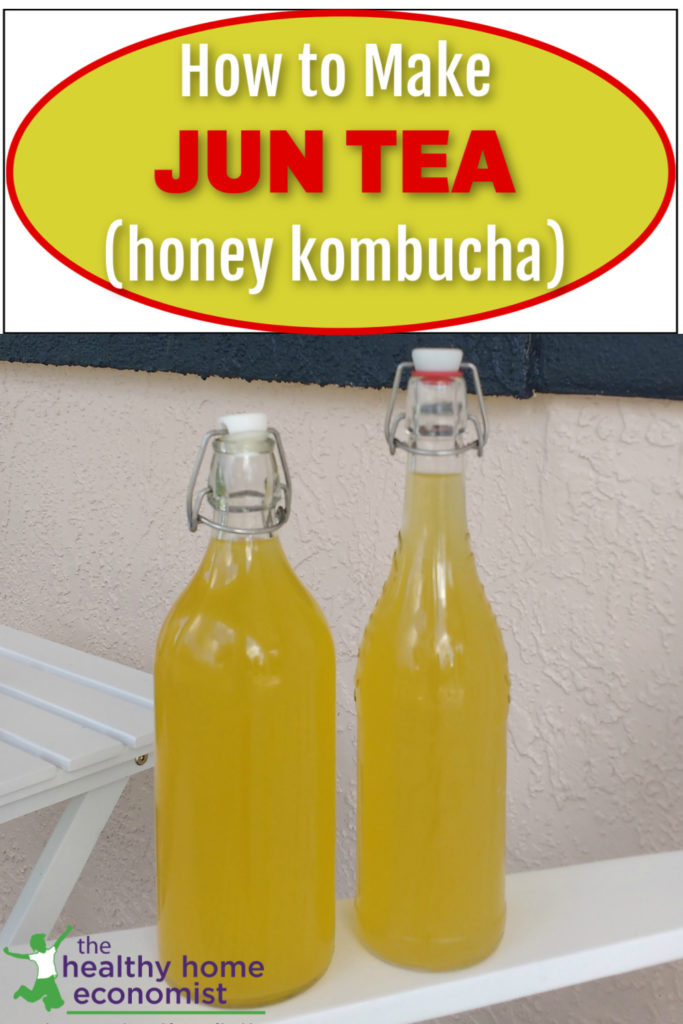Jun tea is made with green tea and raw honey and is the lighter, faster brewing version of kombucha. Try the easy recipe below with how-to video and learn about the history and health benefits of this delightful fermented beverage also called kombucha champagne.

I was gifted my very first Jun tea culture from a friend who told me that he seemed to digest it even better than the fermented drink known as kombucha.
I was excited to learn of a ferment made with honey and green tea instead of black tea and sugar, which is what you use when making kombucha at home.
The reason?
In 2001, shortly after I first began brewing kombucha, a Chinese friend who came to dinner told me her mother had made a very similar drink when she was a child growing up in Guangdong Province. The difference? Her mother made the ferment with green tea and honey.
Ever since that night, I’ve been intrigued by this mysterious ferment. Now I know it was very likely Jun tea.
The History of Jun Tea
Jun is widely found today in western Tibet (the number one place on my bucket list to visit someday) although it’s actual history is shrouded in rumor and mystery.
Some Jun dealers claim that the earliest writings about Jun tea date back to 600 B.C. in Northeast China where the elixir was valued for its ability to open energy (chi) in the body and increase circulation. Unfortunately, no source for these “earliest writings” is actually given.
Jun cultures are precious and a bit hard to find, to say the least. “Heirloom” Jun cultures are apparently so rare, in fact, that there have been robberies of Jun cultures reported by specialty fermentation dealers in recent years with the distribution of daughter cultures of the stolen originals ending up in Hawaii in Colorado.
Jun vs Kombucha
To say that I am in love with this lighter, faster brewing cousin of kombucha would be an understatement! Let’s examine some of the similarities and differences between these cousin ferments.

Uses slightly less tea and sweetener
Where a full gallon of kombucha typically uses 4-5 teaspoons of black tea and 1-1.5 cups sugar, a gallon of Jun requires 4 teaspoons of green tea and 1 cup of honey, ideally locally sourced and raw.
Hence, this is why Jun is sometimes called honey kombucha.
This means that Jun tea would be free of any potential disaccharide residues from the white sugar and hence friendly to those on the GAPS Diet.
Steeping and brewing times are shorter
The (loose) green tea used to make Jun is steeped for only two minutes, whereas for kombucha, steeping time is normally 10 minutes. Brew time is also shorter for Jun – 6 days versus 7 days minimum for kombucha.
This results in a lower caffeine final brew (if any is left at all) with lower potential fluoride content as well if lower quality and/or nonorganic tea is used for budget reasons.
Brews better at cooler temperatures
According to my friends at Kombucha Kamp, the ideal brewing temperature for Jun tea is between 68-77 F (20-25 C). For kombucha, the temperature range for optimal brewing is 78-85 F (25.5-29 C).
As a result, depending on the temperature of your home, either Jun tea or kombucha may make more sense depending on the seasonal effect.
More Expensive to Make
On the downside, brewing Jun tea is significantly more expensive than kombucha. However, it is still far cheaper than buying bottled kombucha from the store.
While I brew kombucha for around 25 cents per quart, the cost of a quart of home-brewed Jun tea is about $2.50, 10 times as much!
The difference in cost is primarily due to the higher price of quality honey as compared to the cane sugar used to make kombucha.
More alcoholic
In addition to the increased cost, Jun tea is more alcoholic (around 2%), with kombucha clocking in at .5% for a typical batch.
Increased alcohol content makes Jun tea inappropriate for children.
In addition, it is not advisable for consumption during pregnancy and breastfeeding. Kombucha, on the other hand, is a ferment I enjoyed all throughout pregnancy and lactation and allowed my children to sip in small amounts starting around age 2.
Should You Try Honey Kombucha?
If you have never made kombucha or other home ferments before, I suggest you start with kombucha as it is far less expensive to make and failure of a batch or two won’t cost you much.
On the other hand, if you are experienced at home ferments, give Jun tea, the champagne of kombucha, a try!
Who knows? You might end up a Jun-kie!
Where to Find a Potent Culture and Starter
Unfortunately, not that many people brew Jun tea, so it is hard to find someone in your community who can share a culture and some starter with you.
Thus, I would suggest buying an authentic Jun culture and starter from Kombucha Kamp. My friends Hannah and Alex will take good care of you and guarantee a full potency culture that is always fresh, never dehydrated or frozen. This is where my culture hails from.
Included in the recipe below is a 3-minute video that overviews the Jun Tea making process. Enjoy!

Jun Tea Recipe (Kombucha Champagne)
This recipe for Jun tea is delicious and easy to make and will delight kombucha fans.
Ingredients
- 1 gallon filtered water preferably not reverse osmosis
- 1 cup raw honey preferably local
- 4 tsp green tea loose, preferably organic
- 1 Jun culture
- 1 cup Jun tea starter
Instructions
-
Heat the water to 165 F/74 C in a large pot. Use a frying or candy thermometer to check the water is not too hot (I use this one).
Hint: Do not boil the water like when making kombucha.
-
Remove the pot from the heat.
-
Place 4 tsp loose tea in a stainless steel tea mesh (I use this one) and hook to the side of the pot. Let steep for 2 minutes.
-
Remove tea mesh and pour hot tea into a fermentation vessel (I use these).
-
Stir in honey and let the mixture come to room temperature.
-
Stir in the starter and stir to mix. Place Jun tea culture on top. Cover with a clean, white tea towel or flour sack cloth (like these) and secure with a large rubber band.
-
Place in a quiet room (the top of a bureau in a guest bedroom or the top of a file cabinet in a home office is perfect). Ideally, not the top of the refrigerator or other appliances as the EMFs will weaken the Jun culture over time).
-
Leave undisturbed and do not move for 3-6 days.
-
Harvest after 3 days if you wish to bottle the Jun tea for 3 more days for additional fizziness (see this video for the how-to) or leave for 6 full days if you don't intend to bottle.
-
Place Jun cultures in a glass jar or bowl with sufficient brewed Jun tea to cover and reserve in the refrigerator for your next batch.
-
Bottled Jun tea should always be very cold and opened in the sink to prevent accidental fizzing over onto the counter and floors.
-
Finished Jun tea should be stored in the refrigerator in clear glass only. No plastic, no enamel, no colored glass.
Recipe Video

More Information
Fluoride in Kombucha: Should You Be Concerned?
Have You tried Kombucha Tea?
Switchel: Nature’s Healthy Gatorade
Can Candida Sufferers Drink Kombucha?
Kombucha: What it is and How to Make it (plus video how-tos)
Does Kombucha Prevent Grey Hair?
Batch vs Continuous Brew Kombucha
Addicted to Store Kombucha? Here’s Why








I’ve used Japanese green tea with a regular scoby and I usually use less sugar and my place is 19 degrees Celsius. Ferment may take 10 days or more but I get a cleaner clearer tasting kombucha than when I use black tea.
I prepare my jun using a continuous brew method, so I top up with about a litre each day and also remove a litre. I rarely refrigerate it, I either drink it straight or do a second ferment with added fruit (eg. lemon and ginger) and leave it on the bench for a day before drinking. Because of the continuous brew, it is always ‘on tap’, so my family can help themselves whenever they want some.
i have been brewing jun tea for a few years. I received my scoby from a kumbucha facebook group. I use the continuous brew method.
I was taught never to refrigerat scobys. They will die.
Sorry to correct you, but all tea made from camellia sinensis contains tannins.
Quote from the people at Wikipedia:
Optimum brewing temperature depends on tea type. Camellia sinensis naturally contains tannins having bitter properties accentuated by both temperature and steeping time. These tannins are enhanced by oxidation during processing. Teas with little or no oxidation, such as a green or white, are best at lower temperatures between 65 and 85 °C (149 and 185 °F), while more oxidized teas require 100 °C (212 °F) to extract their large, complex, flavourful phenolic molecules.
I would take a “correction” from Wikipedia with a grain of salt. 🙂 It’s my understanding that there are fewer tannins in white and green tea than black. That’s why black tea keeps a kombucha SCOBY healthier than just white or green tea. I use a combo of all three in my kombucha.
I’m so new to Jun that I’m waiting on my first batch’s second ferment. Watermelon soda will be enjoyed in a day or two! 🙂
You should mention that tap water may cause serious problems with Jun Tea or kombucha. Here where I live tap water = mold. Also, as a tea connoisseur, for best flavor, not a good idea to brew any tea for more than 5 minutes. Otherwise, you’ll make it bitter. Lived in Asia for 2 years — as I recall apple cider vinegar can also be used as a starter. Since you’re into health food: Here’s a tip: Green plantains (resistant starch activates butyrate) cannot be digested; thus, they’re a great base for making smoothies; furthermore, if you add 3 ozs. of extra virgin olive oil to smoothie, then you,ll cut your inflammation by 40%. Add 2 tbs. pulverized flax seed and you’ll be nearly immune to colon cancer. Sweeten with Stevia; use cinnamon, fresh ginger, lemon juice and flavor extracts for taste.
The recipe calls for filtered water 🙂
I make continuous brew kombucha, which makes it so easy. Can you do continuous brew with jun also?
Thanks
Hi, why should you only use clear glass to store the finished Jun in fridge? I only have pop top green glass bottles.
The color in the glass may be made of questionable ingredients and kombucha and Jun tea are capable of drawing these toxins into the ferment. Best to play it safe and only ever use clear glass for these beverages unless you can be completely sure of the source of the glass.
Glass:
The only concern is heavy metal used for coloring; e.g., lead.
For that reason, most food manufacturers (including olive oil companies) use various known metals that have been proven to be safe. Green is one of those that has a track record of being safe and considered necessary to preserve oleocanthal in olive oil. Due to this track record many beer companies use green bottles for old goats my age.
P.S. If you want nutrition info in private — let me know and I’ll provide a private email.
I have been making green tea kombucha for a very long time. AND I only use 3/4 cup sugar. It brews beautifully. The taste is light and quenching.
Hi! I’ve heard that honey shouldn’t be used in fermented beverages because of its antibacterial properties. Does the honey not kill the bacteria? Thanks for your help in understanding!
Yes, honey is anti-bacterial for pathogens but it ferments just fine with a beneficial Jun tea culture.
When I brewed kombucha, I played around with the recipe. I came to the realization that I liked half grean tea and half black tea. So you don’t necessarily have to use black tea. I never thought about using honey though! Thanks!
I also use half black and half green when I make kombucha and have for years. The cultures are different between kombucha and Jun tea though … it’s not just a matter of using green tea only and raw honey. Also, with a kombucha culture, you must use at least 1 oz black tea per gallon of water … the culture needs the tannins whereas a Jun tea culture does not.
I have been brewing about 7-8 gallons of kombucha per week and only rarely have I used black tea. Black tea is not essential with kombucha. I also brew jun though I can’t say that I have found it as wonderful as I have seen claimed. As noted above, honey should be added to cool-ish tea so as not to destroy the wonderful properties of the honey.